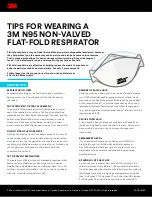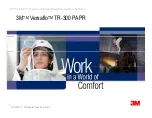
Page 16 of 36
P/N 595225-01 Rev C 4/12
TO TEST LED DISPLAY,
CONTROL NEEDLE BETWEEN
1/4 AND TOP OF "EMPTY"
FIGURE 17
REMOTE GAUGE (MODEL 4.5 GAUGE
SHOWN, OTHER MODELS SIMILAR)
Inspect the operation of the RIT-PAK III portable air supply as follows:
1. Install a FULL air supply cylinder as described in these instructions.
Verify that
the reducer hose coupling is hand tightened to the cylinder valve outlet
and p
ressurize the system by opening the cylinder valve fully (approximately
two and one-half turns). Check all pipe and hose connections for leaks with a
soap solution or similar leak detection liquid. If any leaks are found, remove
the unit from service and tag for repair by authorized personnel.
2. Slowly open the cylinder valve by fully rotating the knob counterclockwise
(approximately 2 1/2 turns). The LED DISPLAY will initialize with all five lights
on for twenty seconds followed by display of cylinder supply level. If the LOW
BATTERY light at the far right of the display remains lit or begins to flash,
replace the batteries according to the BATTERY REPLACEMENT section of
this instruction before proceeding.
3. Check that the remote pressure gauge is operating properly and that it reads
within 10% of the value on the cylinder pressure gauge.
4. Push in and rotate the cylinder valve knob clockwise to close.
5. When the cylinder valve is fully closed, vent the system one of the two fol
-
lowing ways:
a) Carefully push in on the high pressure vent button on the high pressure
connector dust cover.
OR
b) Open the purge valve on the facepiece mounted regulator.
6. As the air pressure vents from the system, the remote pressure gauge needle
will swing from “FULL” and move towards “EMPTY.”
7. Observe the lights of the LED DISPLAY and verify that they light properly in
descending order.
8. Stop venting when the gauge needle crosses the “¼” mark but before the
beginning of the red “EMPTY” band. See
FIGURE
17. The red light on the far
left of the LED DISPLAY shall flash rapidly at ten (10) times per second.
WARNING
IF THE LED DISPLAY INDICATOR LIGHTS
D O N O T A C T U AT E A S D E S C R I B E D
IN THIS INSTRUCTION, DO NOT USE
THE EQUIPMENT UNLESS THERE IS
A COMPELLING REASON TO DO SO.
REMOVE THE AIR SUPPLY FROM SERVICE
AND TAG IT FOR REPAIR BY AUTHORIZED
PERSONNEL. USE OF AN IMPROPERLY
OPERATING AIR SUPPLY MAY RESULT IN
SERIOUS INJURY OR DEATH.
WARNING
LEAKAGE OF AIR FROM THE AIR SUPPLY
MAY INDICATE A POTENTIALLY SERIOUS
DEFECT. AIR LEAKAGE MAY REDUCE THE
DURATION OF USE. USE OF AN AIR SUPPLY
EXHIBITING AN AIR LEAK MAY RESULT IN
EXPOSING THE RESPIRATOR USER TO
THE ATMOSPHERE THE EQUIPMENT IS
INTENDED TO PROTECT AGAINST WHICH
COULD LEAD TO SERIOUS INJURY OR
DEATH.
OPERATIONAL TESTING
For all OPERATIONAL TESTING, install a FULL air supply cylinder as described in these
instructions.
Verify that the reducer hose coupling is hand tightened to the cylinder
valve outlet and p
ressurize the system by opening the cylinder valve fully (approximately
two and one-half turns). Check all pipe and hose connections for leaks with a soap solution
or similar leak detection liquid. If any leaks are found, remove the unit from service and
tag for repair by authorized personnel.
WARNING
CHECK ALL PIPE AND HOSE CONNECTIONS
FOR LEAKS. IF ANY LEAKS ARE DETECTED,
REMOVE THE EQUIPMENT FORM SERVICE
AND TAG FOR REPAIR BY AUTHORIZED
PERSONNEL. AIR LEAKAGE COULD
RESULT IN A LOSS OF AIR AND DIMINISHED
PERFORMANCE OF THE EQUIPMENT
IN AN EMERGENCY SITUATION WHICH
COULD CAUSE SERIOUS INJURY OR
DEATH. AIR LEAKAGE MAY ALSO RESULT
IN SUDDEN UNEXPECTED RUSH OF HIGH
PRESSURE AIR WHICH COULD CAUSE
SERIOUS INJURY OR DEATH.
FIGURE 16
CYLINDER PRESSURE GAUGE
ON CYLINDER VALVE
(4500 PSI GAUGE ILLUSTRATED)
REGULAR OPERATIONAL INSPECTION CONTINUED...
9. After verifying that the LED DISPLAY is functioning properly, vent the remain-
ing residual air pressure from the system. The LED DISPLAY shall cease
operation when the system pressure drops to zero.
CAUTION
OVERTIGHTENING THE CYLINDER VALVE
MAY CAUSE DAMAGE THAT COULD
RESULT IN LEAKAGE OF AIR FROM THE
CYLINDER. USE NO TOOLS TO CLOSE THE
CYLINDER VALVE.






































